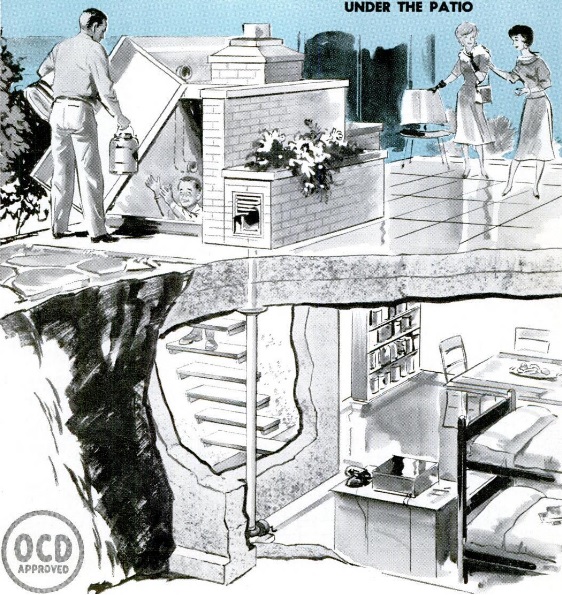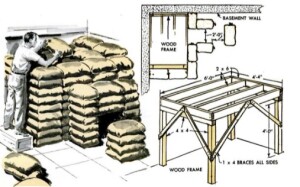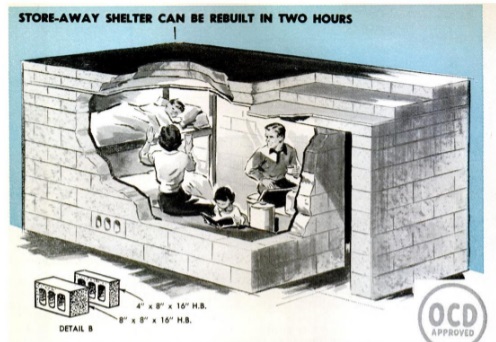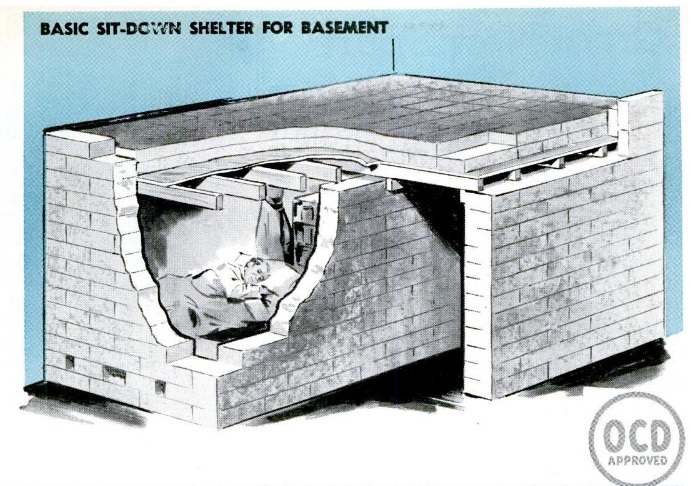 Sixty years ago this month, the Cuban Missile Crisis was still almost a year off, but protection from nuclear weapons was already on the minds of many Americans, and the December 1961 issue of Popular Mechanics carried construction details for four fallout shelters. The deluxe model shown above, with an estimated cost of $1841 (about $17,000 in 2021 dollars) was typical of that offered by commercial builders. It was an underground room that could be used in peacetime for some other use, with an attractive patio on top, complete with a built-in grill.
Sixty years ago this month, the Cuban Missile Crisis was still almost a year off, but protection from nuclear weapons was already on the minds of many Americans, and the December 1961 issue of Popular Mechanics carried construction details for four fallout shelters. The deluxe model shown above, with an estimated cost of $1841 (about $17,000 in 2021 dollars) was typical of that offered by commercial builders. It was an underground room that could be used in peacetime for some other use, with an attractive patio on top, complete with a built-in grill.
 The other end of the cost spectrum was represented by the design shown at left courtesy of Prof. R.M. Stephenson of the University of Connecticut’s nuclear engineering program. He estimated that the design would reduce radiation levels by a factor of 200-1000, meaning that it would save lives even in areas of high fallout. The material consisted of 100 sandbags, 10,000 pounds of dry sand, and some miscellaneous lumber, with a cost of only $30 ($279 in 2021 dollars).
The other end of the cost spectrum was represented by the design shown at left courtesy of Prof. R.M. Stephenson of the University of Connecticut’s nuclear engineering program. He estimated that the design would reduce radiation levels by a factor of 200-1000, meaning that it would save lives even in areas of high fallout. The material consisted of 100 sandbags, 10,000 pounds of dry sand, and some miscellaneous lumber, with a cost of only $30 ($279 in 2021 dollars).
 The next least expensive was the design shown at right, with an estimated cost of $97 (about $900 in 2021). The initial construction of this design was done prior to the emergency, requiring about 33 hours of labor. A wooden frame was mounted to the wall with a hinge for the ceiling, with the concrete blocks stored nearby. In time of emergency, the construction could be completed in about two hours, assuming you were in a hurry, which you probably would be. To save space in this shelter, food and water was to be stored outside, with the occupants brining in a one or two day supply.
The next least expensive was the design shown at right, with an estimated cost of $97 (about $900 in 2021). The initial construction of this design was done prior to the emergency, requiring about 33 hours of labor. A wooden frame was mounted to the wall with a hinge for the ceiling, with the concrete blocks stored nearby. In time of emergency, the construction could be completed in about two hours, assuming you were in a hurry, which you probably would be. To save space in this shelter, food and water was to be stored outside, with the occupants brining in a one or two day supply.
The final design, shown below, could shelter four persons at a cost of $280 ($2600 in 2021 dollars). This design was made mostly of concrete block. Some lumber was used, and the designers recommended that any lumber in contact with existing basement floor or walls be coated with tar or white lead paste to prevent rot.
The magazine offered a booklet with more details about the designs, and also directed readers to the Office of Civil Defense for more free information.
